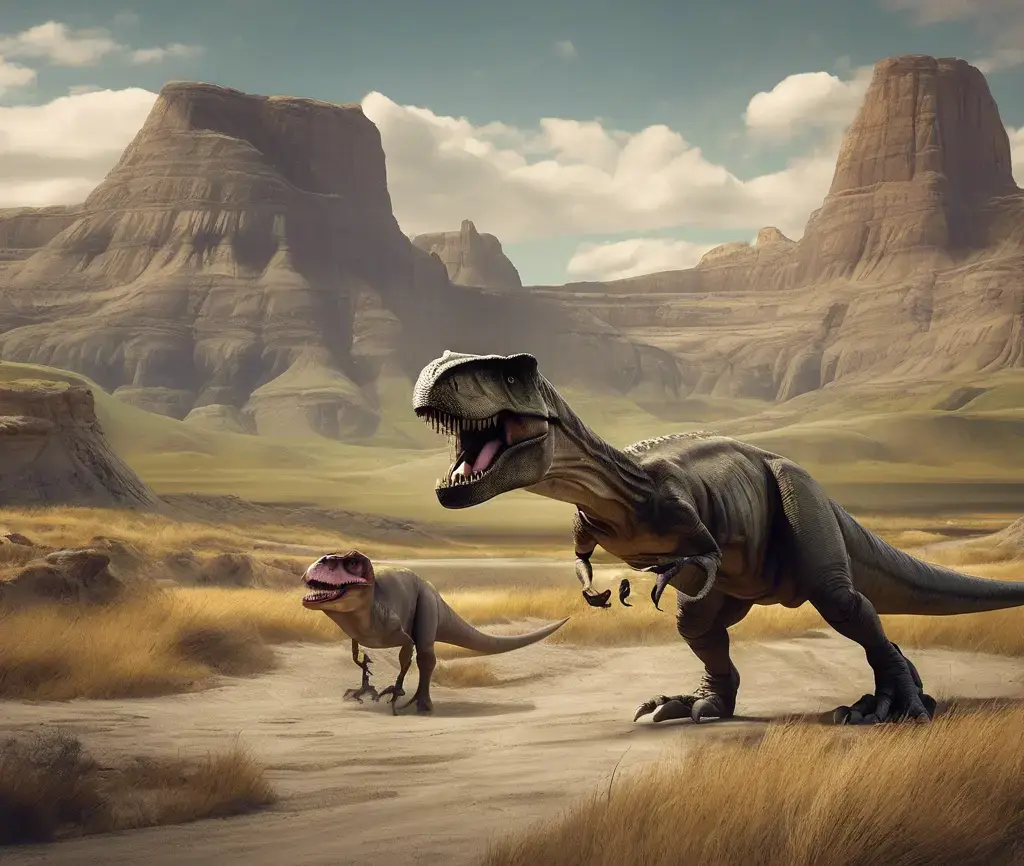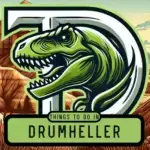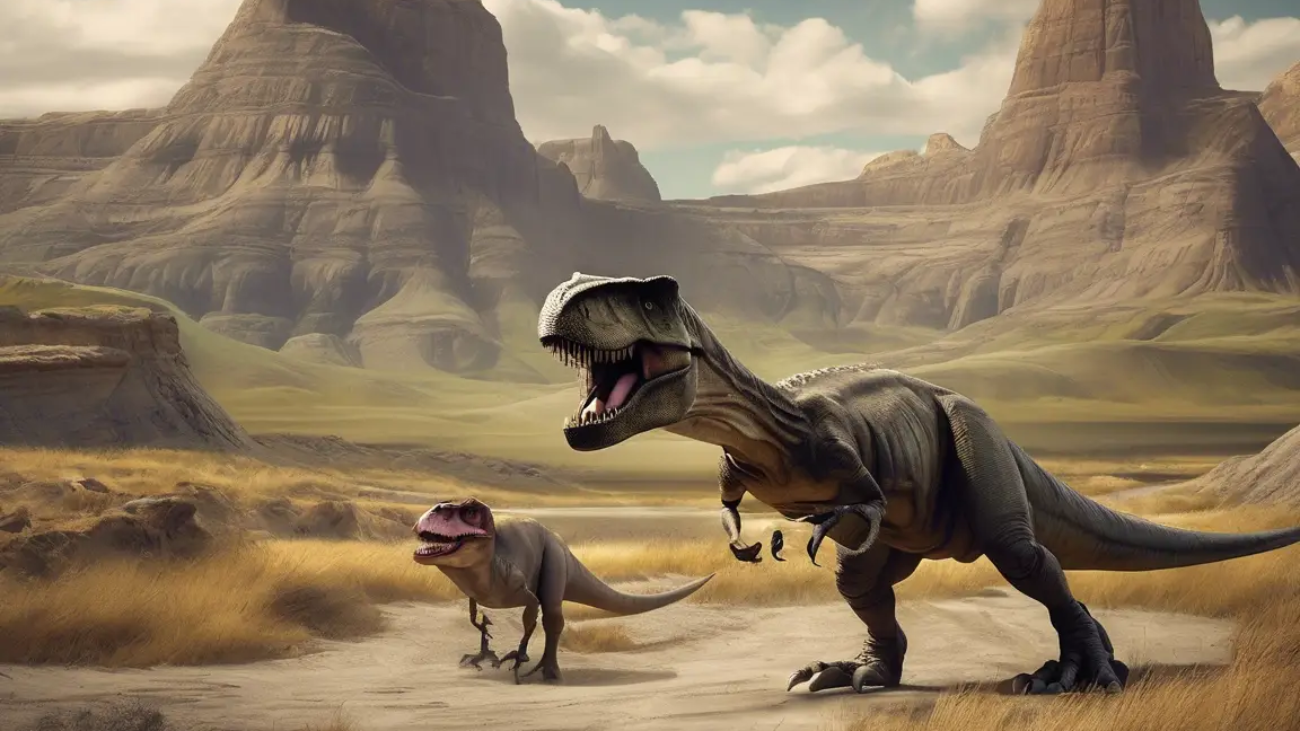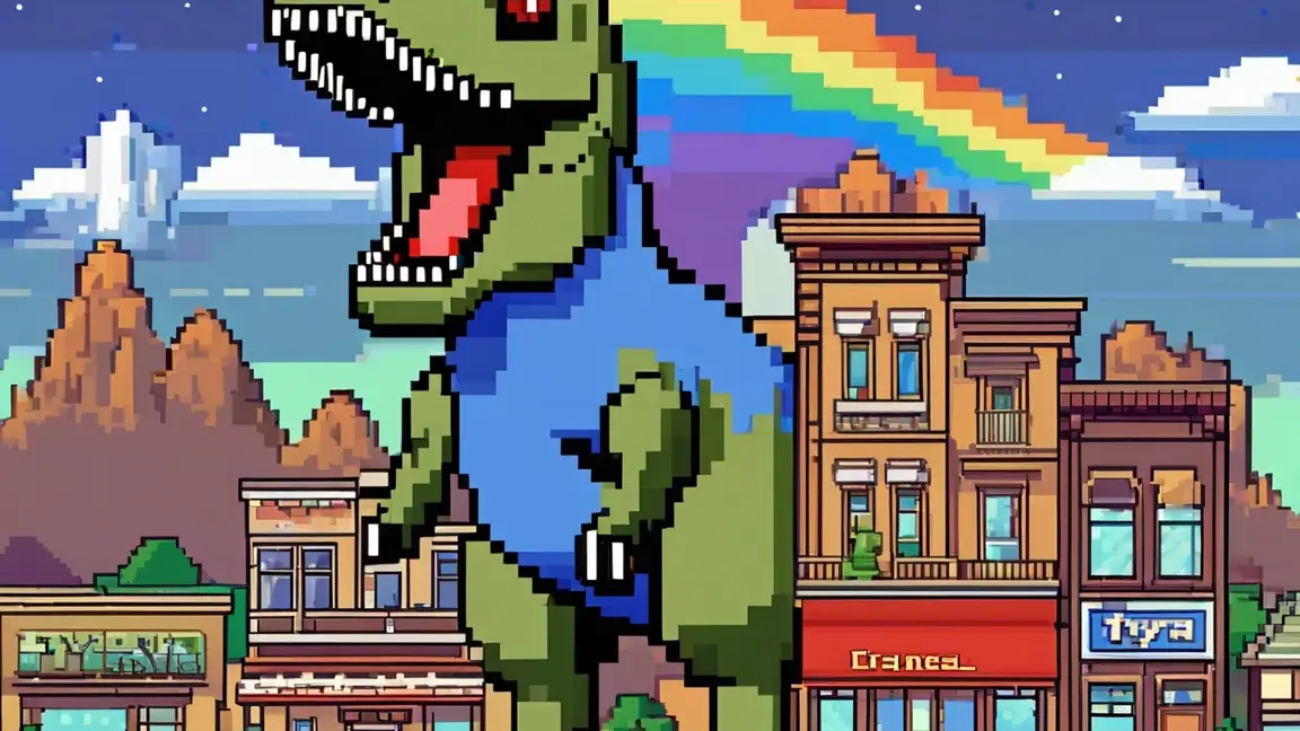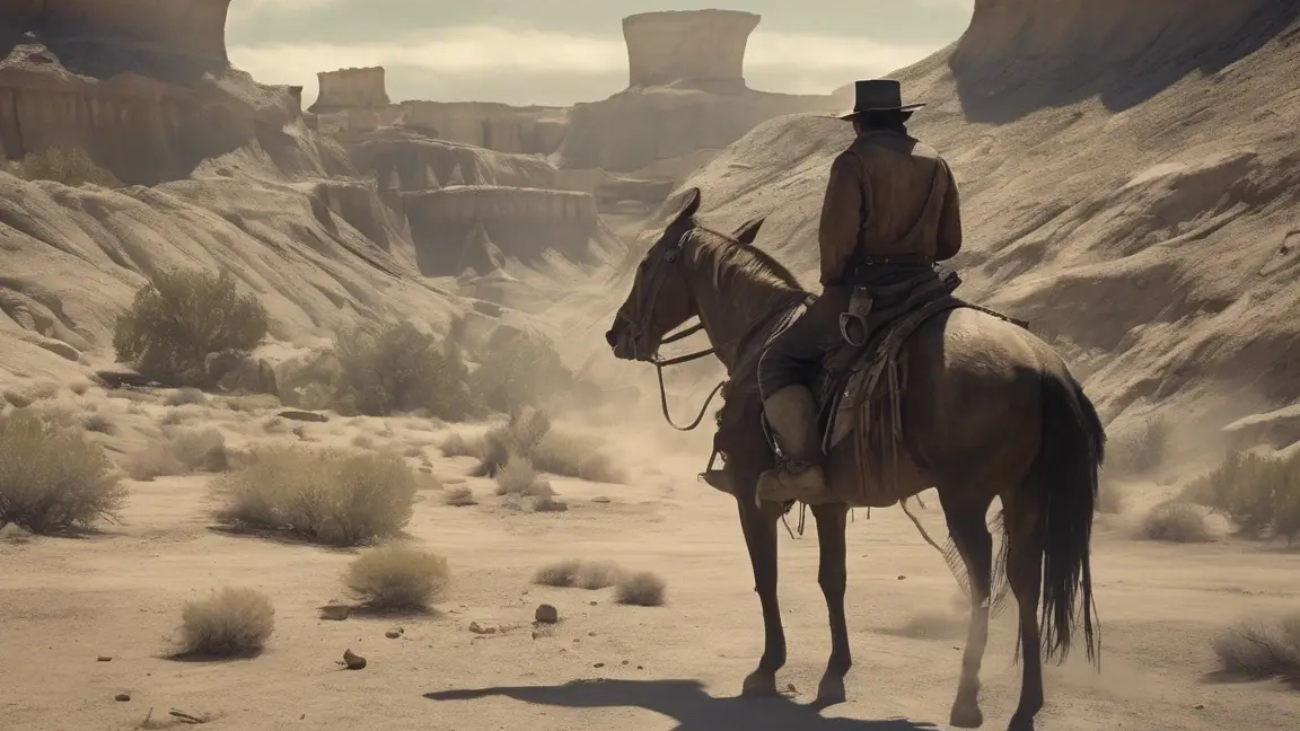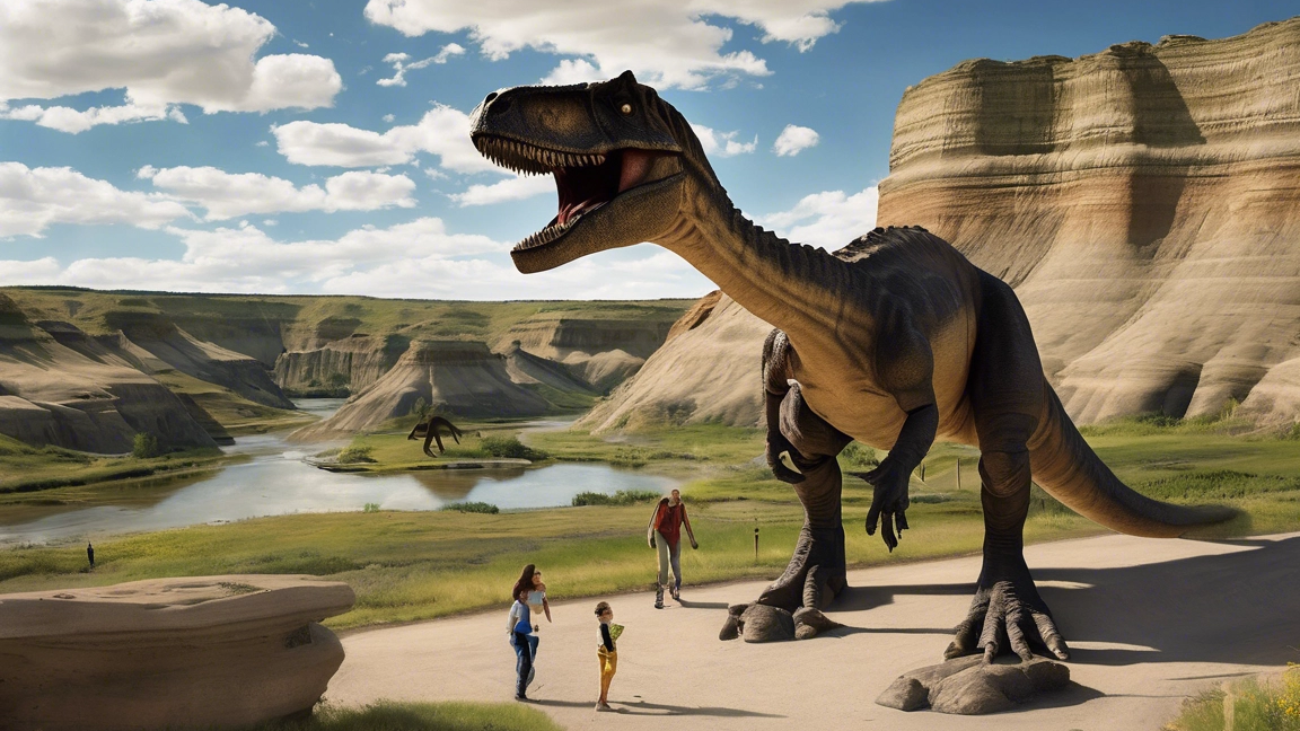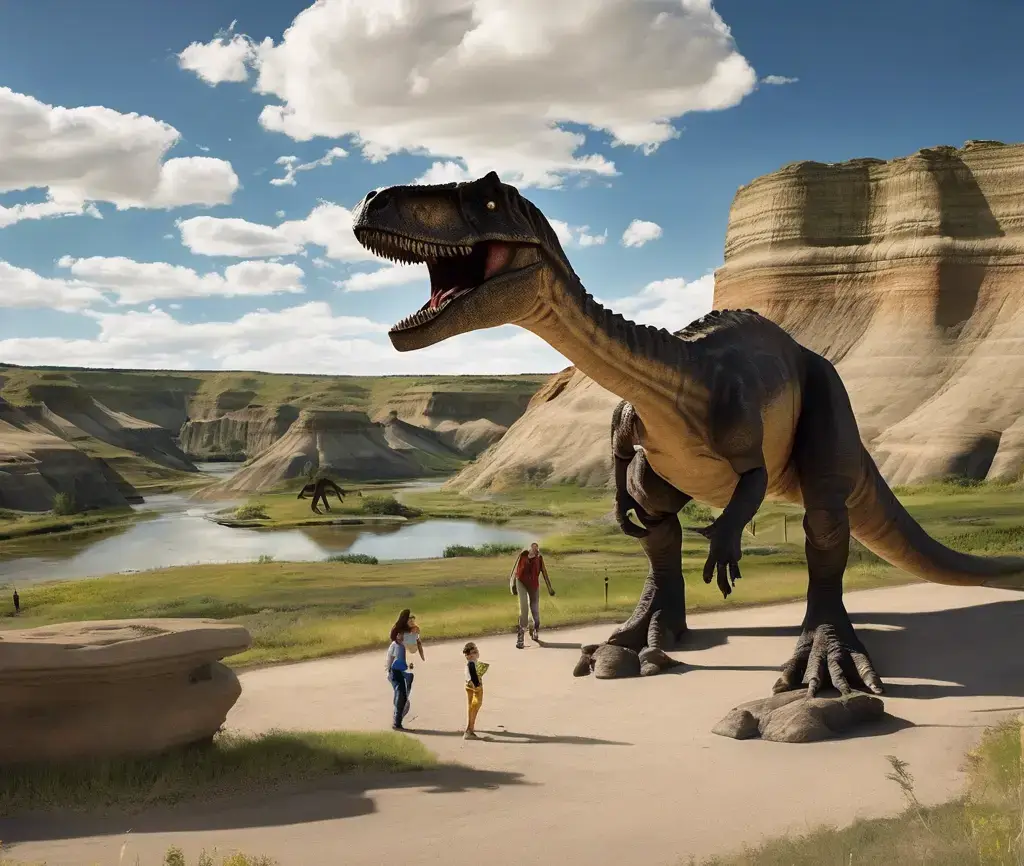Top 50 Coolest Things in Drumheller History: A Badlands Epic
AJ Frey
Things To Do In Drumheller
Dive into Drumheller’s wild history with 50 epic moments—from fossil finds like Black Beauty to cultural legends like the Last Chance Saloon.
Drumheller, Alberta, isn’t just a pin on the map—it’s the beating heart of the Badlands, a rugged wonderland 90 minutes from Calgary where dinosaurs, coal miners, and quirky souls have left their mark. Known as the “Dinosaur Capital of the World,” this town’s history roars with prehistoric bones and hums with human tales. Picture a place where T-Rex skulls pop out of the dirt, where Wild West saloons still pour beers, and where hoodoos stand like silent storytellers. I’ve dug through Drumheller’s past to bring you its 50 coolest moments—10 fossil finds that shook science and 40 cultural gems that shaped its soul. This isn’t a quick list; it’s a deep dive into each epic chapter, no word limit holding us back. From fossils to floods, let’s roll through Drumheller’s wild, Badlands epic!
The Fossil Finds That Made History
Way back in 1884, a geologist named Joseph Burr Tyrrell changed Drumheller forever when he stumbled across a 70-million-year-old Albertosaurus skull near town. Picture him trudging through the Badlands, pickaxe in hand, when he spots this jagged, toothy relic poking out of the dirt. It wasn’t named until 1905, but this find sparked Alberta’s “dinosaur rush,” turning sleepy coulees into a fossil frenzy. Tyrrell’s discovery wasn’t just a skull—it was the match that lit Drumheller’s paleontology fire, leading straight to the Royal Tyrrell Museum we know today. That Albertosaurus, with its fierce jaws and predator swagger, still looms large, a reminder of the Badlands’ prehistoric pulse. Every fossil hunter since owes a nod to that moment when Drumheller’s dino destiny kicked off.
Fast forward to 1980, and two schoolboys fishing near the Crowsnest River reeled in something bigger than trout—a jet-black Tyrannosaurus rex skeleton dubbed Black Beauty. Imagine these kids, rods in hand, spotting bones glinting dark against the riverbank, not knowing they’d unearthed one of the best-preserved T-Rex subadults ever. Its manganese-tinted bones, stained by ancient minerals, give it a sleek, shadowy look that stops you dead at the Royal Tyrrell Museum. This wasn’t just a find; it was a Badlands blockbuster, showing off Drumheller’s knack for hiding treasures in plain sight. Black Beauty’s a star—raw, rare, and a little spooky—proof that even kids can stumble into history here.
In 2011, the Badlands coughed up another gem when an oilsands worker north of Drumheller found Borealopelta, a 110-million-year-old nodosaur that’s the world’s best-preserved armored dinosaur. Picture this tank-like beast, its spiky plates and skin still intact, even its last meal—ferns and twigs—locked in its gut. Hauled to the Tyrrell, it’s like a time capsule you can touch, a snapshot of a Cretaceous grazer caught mid-munch. This wasn’t just a fossil; it was a full-on dino mummy, showing Drumheller’s dirt holds secrets deeper than most dare dream. Borealopelta’s a Badlands marvel, a testament to how this land keeps rewriting science.
The year 1995 brought the World’s Most Complete Ornithomimus out of Dinosaur Provincial Park, a spot tied tight to Drumheller’s fossil fame. Imagine an “ostrich mimic” skeleton, sleek and feathered, missing only a few toe bones—good enough for a Guinness World Record. Unearthed in the Badlands’ layered sands, this near-perfect find gave scientists a front-row seat to a speedy dino’s life 70 million years back. It’s not just a pile of bones; it’s a runner caught mid-stride, a Drumheller-area treasure that proves these coulees don’t mess around. That Ornithomimus stands tall at the Tyrrell, a feather-light legend in a heavy-hitting fossil lineup.
Back in the 1980s, a massive Centrosaurus herd bone bed surfaced in Dinosaur Provincial Park, revealing over 1,000 horned dinos drowned in a flood 76 million years ago. Picture a chaotic scene—hundreds of these frilled beasts swept away, their bones piling up in a muddy grave now cracked open by the Badlands sun. This wasn’t just a find; it was proof of herd life, a rare peek at how these dinos rolled together before disaster struck. Linked to Drumheller’s fossil legacy, it’s a Tyrrell highlight that paints a wild, watery end. That bone bed’s a Badlands time machine, showing life—and death—in dino herds.
Fossils from the Drumheller area, pieced together over years, gave us the Gorgosaurus vs. Centrosaurus scene—a predator-prey showdown frozen in time. Imagine a lean Gorgosaurus, jaws clamped on a Centrosaurus, its horns no match for those teeth, both locked in the dirt for millions of years. Displayed at the Tyrrell, this dynamic duo captures a raw moment of Cretaceous carnage right from the Badlands’ heart. It’s not just bones; it’s a story of hunter and hunted, a Drumheller classic that makes you feel the chase. This find’s a testament to how these coulees keep serving up drama.
The 1980s also delivered Canada’s Best Triceratops Skull, dug up near Drumheller with its iconic horns and frill nearly intact. Picture this three-horned giant, its skull a tank-like beauty, hauled from the Badlands to the Tyrrell where it’s a showstopper. Those horns—two long, one stubby—and that shield-like frill scream prehistoric power, a perfect specimen from 68 million years back. It’s not just a fossil; it’s a crown jewel, proving Drumheller’s dirt churns out the best of the best. This Triceratops skull’s a Badlands badge of honor, a must-see for any dino nut.
In 1910, a Hypacrosaurus hatchling popped out of Drumheller’s soil, a duck-billed baby with a tiny crest that’s pure dino cuteness. Imagine this little guy, barely hatched, its juvenile skeleton offering clues to how these plant-munchers grew up 75 million years ago. One of the first of its kind found, it’s a Tyrrell gem that softens the Badlands’ tough edge. This wasn’t just a find; it was a peek into dino daycare, a rare glimpse at life before the big leagues. That hatchling’s a Drumheller darling, showing even the smallest bones tell big stories.
Late 20th-century digs brought up Xiphactinus, a 6-meter marine predator from the Drumheller region, with a Gillicus fish still in its belly. Picture this fierce swimmer, jaws wide, caught mid-meal 80 million years ago, preserved in the Badlands’ depths. It’s not your typical land dino—this sea beast ruled ancient waters, and its last supper makes it a Cretaceous snapshot. Housed at the Tyrrell, it’s a wild card in Drumheller’s fossil deck, proving the area’s history dips below the waves. Xiphactinus is a Badlands badass, a watery warrior worth a gawk.
Multiple Chasmosaurus finds over the years rounded out Drumheller’s dino roster, their ornate frills and horns lighting up the Late Cretaceous scene. Imagine these ceratopsians, their headgear flashy and fierce, stomping through what’s now Badlands turf 75 million years back. Scattered across the region, these fossils at the Tyrrell show off Alberta’s diversity in style and swagger. They’re not just bones; they’re a parade of prehistoric flair, a Drumheller signature. Chasmosaurus proves this town’s fossil game is deep and dazzling.
The Cultural Milestones That Shaped Drumheller
Long before anyone swung a pickaxe, the Blackfoot and Cree saw the Badlands’ fossil beds as sacred, calling them “grandfathers of the bison.” Picture these Indigenous folks, pre-contact, weaving tales around bones poking from the dirt, tying them to their spiritual world. Those fossils weren’t just rocks—they were ancestors, a link to the land that’s still felt today. This reverence set Drumheller apart, rooting its history in First Nations lore way before science stepped in. It’s a quiet, powerful thread that runs through the Badlands’ soul.
In 1793, explorer Peter Fidler rolled through, the first European to clock coal seams and massive bison herds near Drumheller. Imagine him scribbling in his journal, wide-eyed at the shaggy beasts thundering across the plains, hinting at the riches below. That coal sighting wasn’t just a note—it was the spark for Drumheller’s mining future, a heads-up to what’d come. Fidler’s trek painted a prehistory picture, setting the stage for a town built on black gold. His bison herd moment’s a Badlands postcard from the past.
The early 1900s flipped Drumheller into overdrive when rich coal seams sparked a mining boom. Picture over 130 mines buzzing by the 1920s, turning a sleepy valley into a gritty hub of picks, dust, and sweat. That coal didn’t just heat homes—it fueled growth, drawing workers who’d shape the town’s backbone. This wasn’t a quiet rise; it was a roar, a Badlands transformation from wild land to working heart. The coal boom’s legacy lingers in every old shaft and story.
By 1936, the Atlas Coal Mine opened its gates, a major player now a National Historic Site where you can climb the last wooden tipple standing. Imagine miners hauling coal from deep shafts, the air thick with dust, building Drumheller’s industrial cred. It wasn’t just a mine—it was a lifeline, pumping out black gold for decades. Today, it’s a time capsule, letting you walk the tracks of a coal-powered past. Atlas is a Badlands monument to grit and grind.
The Royal Tyrrell Museum threw open its doors in 1985, turning Drumheller into a global fossil mecca overnight. Picture half a million visitors a year flooding in, jaws dropping at T-Rexes and Triceratops under one roof. This wasn’t just a museum—it was a game-changer, putting Drumheller on maps worldwide. Named for that 1884 Albertosaurus find, it’s the Badlands’ crown jewel, a science hub with small-town roots. The Tyrrell’s debut made Drumheller a dino destination for the ages.
In 1990, Queen Elizabeth II gave the Tyrrell her “Royal” stamp, a nod that cemented its prestige. Imagine Her Majesty’s visit, dubbing it official, a moment that echoed from Buckingham Palace to the Badlands. That royal touch wasn’t just pomp—it was pride, lifting Drumheller’s fossil fame to new heights. It’s a cool badge, a reminder this town’s history punches above its weight. The “Royal” tag’s a Badlands boast worth bragging about.
The year 2000 saw the World’s Largest Dinosaur rise—Tyra, a 25-meter T-Rex you can climb for a Badlands view. Picture this goofy giant looming over downtown, a quirky landmark that screams Drumheller’s dino love. It’s not just a statue—it’s a rite, drawing thousands yearly to snap pics and scale its stairs. Tyra’s a playful pivot from coal to tourism, a Badlands beacon of fun. This T-Rex turned Drumheller into a selfie spot with teeth.
Out in Wayne, the Last Chance Saloon opened in 1913, a Wild West relic born in the coal boom. Imagine miners and outlaws slugging beers, bullet holes still pocking the walls, ghost stories swirling with every pint. This wasn’t just a bar—it was a time warp, a rowdy hangout that’s dodged the wrecking ball. Still serving today, it’s a Badlands legend, tying Drumheller to its rough-and-tumble roots. Last Chance is history you can sip.
The Bleriot Ferry started chugging across the Red Deer River in 1913, Alberta’s oldest cable ferry and a Drumheller lifeline. Picture this wooden relic, ferrying folks on Highway 10, a slow, charming link to the past. It got rock fame in Tom Cochrane’s “Life Is a Highway” video, cruising into the ’90s spotlight. It’s not just transport—it’s a Badlands icon, a nod to simpler days. Bleriot’s a cool crossing that keeps rolling.
In 2005, the Red Deer River flooded downtown Drumheller, a muddy mess that tested the town’s mettle. Imagine water swallowing streets, locals wading in to save what they could, proving Badlands grit runs deep. It wasn’t just a disaster—it was a rally, a moment that showed Drumheller’s heart. The flood’s scars linger, but so does the spirit that fought back. This was a cool, chaotic chapter in the town’s tale.
Tom Cochrane’s “Life Is a Highway” video shoot in 1991 put Drumheller on the rock map, filming along Highway 10. Picture convertibles tearing past hoodoos, the Bleriot Ferry in the frame, Cochrane strumming in the Badlands glow. It wasn’t where he wrote it, but it’s where the song found its soul, a global hit with a Drumheller stamp. This moment’s a cool collision of music and landscape. The Badlands rocked that day.
The hoodoos got protected status in 1987, those eerie sandstone pillars off Highway 10 locked in as a natural wonder. Imagine these mushroom-topped marvels, tied to Indigenous tales, standing tall under a preservation order. They’re not just rocks—they’re Badlands art, a geological gift that’s dodged erosion’s axe. This move kept Drumheller’s weird beauty alive for all. It’s a cool save for a timeless treasure.
The first Drumheller Stampede kicked off in the 1960s, blending cowboy culture with Badlands flair. Picture rodeo riders roping calves, dust flying, crowds cheering in this rugged valley. It wasn’t just an event—it was a tradition, still drawing folks yearly with boots and bravado. This stampede’s a cool nod to Drumheller’s wild side, beyond the fossils. It’s cowboy cool in dino land.
In 1968, the Little Church popped up—a six-seater chapel that’s pure Drumheller oddball charm. Imagine this tiny pew-box, barely bigger than a shed, drawing tourists to squeeze in and snap pics. It’s not just a building—it’s a quirk, a symbol of the town’s playful spirit. Built for laughs and prayers, it’s stood the test of time. This little gem’s a Badlands delight.
The Starland Recreation Area opened in the 1970s, a stargazing haven tapping Drumheller’s dark skies. Picture folks sprawled under a cosmic blanket, the Milky Way blazing above the coulees, no city lights to dim it. It’s not just a park—it’s a portal, a cool escape into the Badlands’ celestial side. Starland’s a quiet win for night owls. The stars here shine extra bright.
Dinosaur Provincial Park nabbed UNESCO status in 1979, a fossil-rich zone tied to Drumheller’s legacy. Imagine this sprawling badland, bones everywhere, earning a global nod for its dino haul. It’s not just a park—it’s a world stage, boosting the region’s rep as a fossil hotbed. That UNESCO tag’s a cool crown for Drumheller’s prehistoric pull. It’s a badge of Badlands honor.
The 1980s saw Drumheller’s coal mines close, ending an era but sparking a new one. Picture the last picks stilled, miners hanging up their hats, the town pivoting to tourism with grit intact. It wasn’t just a shutdown—it was a shift, trading black gold for fossil fame. This moment reshaped Drumheller’s future, cool in its resilience. The Badlands rolled with the punch.
The Canadian Badlands Passion Play debuted in 1994, turning Drumheller’s natural amphitheater into a stage. Imagine thousands watching this epic unfold, the coulees echoing with drama, a cultural spectacle under open sky. It’s not just a show—it’s a tradition, drawing crowds yearly with faith and flair. This play’s a cool blend of art and landscape. Drumheller’s hills sing a different tune here.
Midland Provincial Park opened in 1979, a quiet gem near the Tyrrell with trails and Badlands views. Picture rolling hills, the Red Deer River glinting below, a peaceful escape from dino hype. It’s not just a park—it’s a breather, a cool spot for locals and visitors to roam free. Midland’s a slice of Drumheller’s wild heart. It’s nature with a side of calm.
The Drumheller Dino Walk hit downtown in the 2000s, scattering over 20 dino statues for a fossil-fueled stroll. Imagine T-Rexes and Triceratops popping up on corners, turning a walk into a hunt—pure Drumheller fun. It’s not just decor—it’s a vibe, a cool way to live the dino dream. This walk’s a Badlands playground for all ages. It’s dino cool, street-style.
Rosebud Theatre fired up in the 1980s, a cultural hub just 25 minutes from Drumheller. Picture this tiny hamlet’s stage, spinning rural Alberta tales with heart and grit, a short hop for a night out. It’s not just plays—it’s a lifeline, a cool thread in the Badlands’ fabric. Rosebud’s a creative kick that complements Drumheller’s wild side. It’s art with soul.
Horseshoe Canyon turned into a tourist hotspot in the 20th century, a U-shaped wonder west of town. Imagine hikers and shutterbugs flocking to this striped marvel, its walls a Badlands canvas 17 kilometers out. It’s not just a canyon—it’s a draw, a cool slice of nature’s art. Horseshoe’s a Drumheller must-see that keeps pulling crowds. It’s raw beauty, pure and simple.
The first Hoodoo RV Park opened in the 1980s, camping right by those funky pillars. Picture RVs nestled near sandstone spires, travelers soaking in the Badlands’ weird glow, a road-trip dream spot. It’s not just a campground—it’s a vibe, a cool base for hoodoo hunts. This park cemented Drumheller’s pull for wanderers. It’s a Badlands sleepover with style.
Drumheller Valley Ski Hill started in the 1960s, a small slope on the river valley’s edge. Imagine locals shredding powder, a winter thrill in a land known for dust and dinos, a cool twist on Badlands fun. It’s not just a hill—it’s a surprise, bringing snowy kicks to the coulees. This ski spot’s a quirky gem in Drumheller’s playbook. It’s chill in every sense.
Bernie and the Boys opened in the 1970s, a burger joint slinging mammoth patties that became legend. Picture this diner on 3rd Avenue West, dishing out 24-ounce beasts that fuel fossil chasers, a Food Network fave. It’s not just food—it’s a rite, a cool taste of Drumheller’s hearty side. Bernie’s a Badlands institution that keeps bellies full. It’s burger bliss, pure and simple.
Wayne peaked in the 1920s as a ghost town near Drumheller, booming with 3,000 miners before fading. Imagine a bustling coal hub, then silence, its eerie remnants now a draw for explorers off Highway 10. It’s not just a ruin—it’s a story, a cool echo of the boom days. Wayne’s a Badlands ghost that whispers history. It’s a haunt worth a detour.
The Drumheller Mail launched its first issue in 1911, a paper chronicling coal, floods, and dino finds. Picture ink-stained pages spilling valley tales, a voice for miners and dreamers in a growing town. It’s not just news—it’s a lifeline, a cool record of Drumheller’s pulse. The Mail’s a Badlands time capsule still flipping today. It’s words that built a legacy.
The 11 Bridges of Rosebud River got mapped in the 20th century, a quirky stretch off Highway 10. Picture one-lane crossings, each a scenic detour over rippling water, a cool twist on a Badlands drive. It’s not just infrastructure—it’s charm, a trail that lures adventurers. These bridges are Drumheller’s little secret, a bumpy delight. They’re a road less traveled, done right.
The Drumheller Aquaplex splashed open in the 1980s, an indoor pool breaking the Badlands dust. Imagine kids cannonballing, travelers cooling off, a watery oasis in a dry land, a cool escape from the heat. It’s not just a swim spot—it’s a breather, a community hub with waves. The Aquaplex is Drumheller’s splash of fun. It’s wet relief in dino country.
The first Badlands Marathon ran in the 2000s, a sweaty salute to Drumheller’s rugged trails. Picture runners pounding through coulees, huffing past hoodoos, a test of grit under the Badlands sun. It’s not just a race—it’s a rite, a cool challenge that draws the brave. This marathon’s a Drumheller tradition that keeps legs pumping. It’s a run with a view.
The Rosedale Suspension Bridge swung up in 1931, a bouncy crossing over the Red Deer River. Imagine folks swaying across, the valley sprawling below, a historic thrill that’s still standing strong. It’s not just a bridge—it’s a kick, a cool link to Drumheller’s past. This bouncer’s a Badlands icon worth a wobble. It’s old-school cool, river-style.
Drumheller claimed its “Dinosaur Capital” title in the 20th century, branding itself a fossil hub. Picture the town leaning into its dino cred, a cool move that stuck worldwide, from Tyrrell to Tyra. It’s not just a name—it’s a crown, a badge of Badlands pride. This claim’s a Drumheller flex that keeps drawing crowds. It’s a title earned in bone.
Peter Fidler’s bison herd sighting in 1793 painted a wild prehistory near Drumheller. Imagine his jaw dropping at thousands of shaggy beasts thundering across the plains, a scene lost to time. It’s not just a note—it’s a vision, a cool glimpse before coal and dinos took over. Fidler’s herd is a Badlands memory that roars. It’s the past in full gallop.
The coal miners’ strike of 1925 lit a fire in Drumheller’s labor history, a walkout for better days. Picture miners downing tools, marching for fair pay and safety, a bold stand in the dust. It’s not just a protest—it’s a spark, a cool moment of fight in a tough town. This strike’s a Badlands tale of guts. It’s history with muscle.
Hoodoo Trail interpretive signs went up in the 1990s, sharing geology and Indigenous stories. Imagine plaques dotting the path, explaining those weird pillars and their sacred roots, a cool nod to learning. It’s not just info—it’s a bridge, linking past to present in the Badlands. These signs make Drumheller’s hoodoos talk. They’re a lesson worth reading.
Drumheller’s first film shoot hit in the 1970s, Hollywood tapping the Badlands’ eerie look. Picture crews rolling in, cameras catching coulees for the big screen, a cool debut for a wild set. It’s not just a movie—it’s a spotlight, kicking off a filming legacy. This shoot put Drumheller in the credits. It’s a Badlands close-up.
The Vintage Tap Room opened in the 2000s, pouring craft beer and live tunes downtown. Imagine this pub buzzing on 3rd Avenue West, a cool hangout for locals and travelers alike, burgers on the side. It’s not just a bar—it’s a vibe, a Badlands nightlife kick. Vintage’s a Drumheller gem that keeps pouring. It’s hops with heart.
The Badlands Community Facility debuted in 2011, a modern hub for sports and events. Picture this sleek spot hosting games and gatherings, a cool upgrade for a growing town, right in the valley. It’s not just a building—it’s a heartbeat, pumping community life. This facility’s a Badlands win for today. It’s where Drumheller plays.
The Dark Sky Push kicked off in the 2020s, fighting to keep Drumheller’s starry nights pristine. Imagine locals and stargazers uniting, shielding those cosmic views from light pollution, a cool celestial stand. It’s not just a cause—it’s a gift, spotlighting the Badlands’ night magic. This push keeps Drumheller twinkling. It’s a sky worth saving.
First Nations sage use weaves through Drumheller’s pre-contact past, a Blackfoot and Cree ritual. Picture smoke rising near fossil beds, ceremonies honoring the land, a cool thread still alive today. It’s not just history—it’s a root, a Badlands tradition deeper than coal or dinos. This sage burns bright in Drumheller’s story. It’s a sacred start.
Drumheller’s history isn’t a quiet tale—it’s a roaring epic of fossils, coal, and quirks. From Tyrrell’s skull to the Dark Sky fight, these 50 moments make the Badlands a legend. It’s a town where the past meets the present, loud and proud.
As you wander through Drumheller’s wild wonders, don’t forget to dive into the local magic that keeps this town roaring! Swing by Treasure Box Toys for a playful treasure hunt—think toys, games, and pure joy for all ages. Craving a snack? Hit up the Munchie Machine for a quick, quirky bite that’s as fun as it is tasty. While you’re at it, explore Smith & Son Pawn and Loan for unique finds that tell their own stories. And for a keepsake that’s pure Badlands gold, grab a Drumheller Dinosaurs Colouring Book to colour your own prehistoric adventure. These local gems are the heartbeat of our town—support them, explore them, and let Drumheller’s spirit spark your next big discovery!
